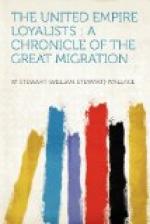The lack of a clergy was even more marked. When Bishop Mountain visited Upper Canada in 1794, he found only one Lutheran chapel and two Presbyterian churches between Montreal and Kingston. At Kingston he found ’a small but decent church,’ and about the Bay of Quinte there were three or four log huts which were used by the Church of England missionary in the neighbourhood. At Niagara there was a clergyman, but no church; the services were held in the Freemasons’ Hall. This lack of a regularly-ordained clergy was partly remedied by a number of itinerant Methodist preachers or ‘exhorters.’ These men were described by Bishop Mountain as ’a set of ignorant enthusiasts, whose preaching is calculated only to perplex the understanding, to corrupt the morals, to relax the nerves of industry, and dissolve the bands of society.’ But they gained a very strong hold on the Loyalist population; and for a long time they were familiar figures upon the country roads.
For many years communications both in New Brunswick and in Upper Canada were mainly by water. The roads between the settlements were little more than forest paths. When Colonel Simcoe went to Upper Canada he planned to build a road running across the province from Montreal to the river Thames, to be called Dundas Street. He was recalled, however, before the road was completed; and the project was allowed to fall through. In 1793 an act was passed by the legislature of Upper Canada ’to regulate the laying out, amending, and keeping in repair, the public highways and roads.’ This threw on the individual settler the obligation of keeping the road across his lot in good repair; but the large amount of crown lands and clergy reserves and land held by speculators throughout the province made this act of little avail. It was not until 1798 that a road was run from the Bay of Quinte to the head of Lake Ontario, by an American surveyor named Asa Danforth. But even this government road was at times impassable; and there is evidence that some travellers preferred to follow the shore of the lake.
It will be seen from these notes on social history that the Loyalists had no primrose path. But after the first grumblings and discontents, poured into the ears of Governor Haldimand and Governor Parr, they seem to have settled down contentedly to their lot; and their life appears to have been on the whole happy. Especially in the winter, when they had some leisure, they seem to have known how to enjoy themselves.




